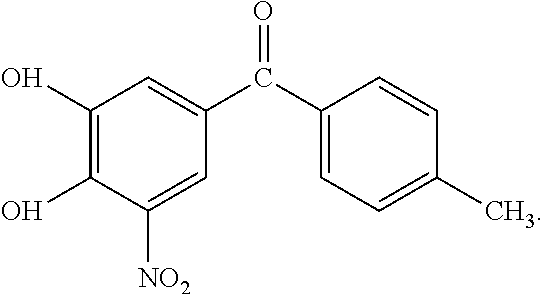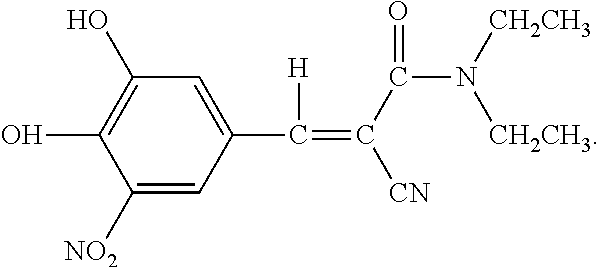Treating impulse control disorders with catechol-o-methyl-transferase inhibitors
- Summary
- Abstract
- Description
- Claims
- Application Information
AI Technical Summary
Benefits of technology
Problems solved by technology
Method used
Image
Examples
examples 1 and 2
Tolcapone in the Treatment of Pathological Gambling
[0070]In example 1, six subjects have been enrolled in a study to determine the effects of administration of the COMT inhibitor tolcapone on gambling. Subjects receive 100 mg-300 mg of tolcapone by mouth per day for 8 weeks, which can be administered either once per day for the 100 mg dose, or multiple (e.g., 3) times per day for higher doses (e.g., 300 mg dose). Five of the 6 (83%) subjects have “responded” (i.e., greater than 35% on the primary outcome measure, the PG-YBOCS) to tolcapone. In most open-label studies of pathological gambling, response rates are approximately 65%.
[0071]Decrease in gambling symptoms was from a mean of 20.4 to 8.0 at endpoint using the PG-YBOCS. This compares to a mean decrease of 6 points on this same scale when used in treatment studies involving other medications.
[0072]The mean effective dose was 140 mg / day.
[0073]Cognitive measures demonstrate significant improvement on the extradimensional set shif...
example 3
Tolcapone in the Treatment of Kleptomania
[0079]Patient was a 60-year old, married, college-educated female with no children. She presented for psychiatric evaluation for “out-of-control” shoplifting that had been going on since early adulthood. Although never arrested for her shoplifting, she reported stealing approximately 90% of the times when she went shopping. Patient primarily stole clothing (usually in sizes that did not fit her) and other personal items such as makeup and hair products. She denied wanting or needing the items and in fact usually discarded them in the trash when she returned home. She reported that when she initially stole items in early adulthood the act gave her a “rush” or a thrill. Over the years, she described the behavior as “automatic” and without awareness for the consequences.
[0080]The diagnosis of kleptomania was confirmed using the Structured Clinical Interview for Kleptomania. Patient also underwent a comprehensive psychiatric evaluation using the ...
PUM
| Property | Measurement | Unit |
|---|---|---|
| Mass flow rate | aaaaa | aaaaa |
Abstract
Description
Claims
Application Information
 Login to View More
Login to View More - R&D
- Intellectual Property
- Life Sciences
- Materials
- Tech Scout
- Unparalleled Data Quality
- Higher Quality Content
- 60% Fewer Hallucinations
Browse by: Latest US Patents, China's latest patents, Technical Efficacy Thesaurus, Application Domain, Technology Topic, Popular Technical Reports.
© 2025 PatSnap. All rights reserved.Legal|Privacy policy|Modern Slavery Act Transparency Statement|Sitemap|About US| Contact US: help@patsnap.com


